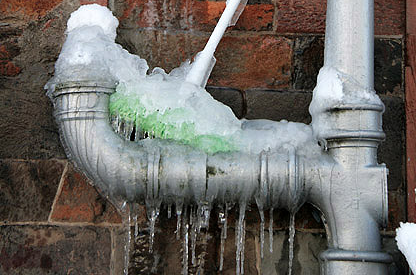Are you currently looking for advice on Preventing and dealing with frozen pipes?

Winter can wreak havoc on your pipes, particularly by freezing pipelines. Here's exactly how to stop it from happening and what to do if it does.
Intro
As temperatures decrease, the threat of frozen pipes boosts, possibly resulting in expensive repairs and water damages. Recognizing just how to stop icy pipelines is crucial for homeowners in cold environments.
Avoidance Tips
Protecting susceptible pipes
Cover pipes in insulation sleeves or use warm tape to safeguard them from freezing temperature levels. Concentrate on pipes in unheated or external locations of the home.
Heating strategies
Keep indoor areas sufficiently heated, specifically areas with pipes. Open cupboard doors to allow warm air to flow around pipes under sinks.
Exactly how to recognize frozen pipelines
Search for reduced water circulation from faucets, uncommon odors or noises from pipelines, and noticeable frost on revealed pipes.
Long-Term Solutions
Structural changes
Consider rerouting pipes away from exterior wall surfaces or unheated locations. Include added insulation to attic rooms, cellars, and crawl spaces.
Updating insulation
Buy top quality insulation for pipes, attics, and walls. Proper insulation helps keep regular temperature levels and decreases the threat of frozen pipes.
Shielding Outdoor Plumbing
Yard hoses and exterior taps
Disconnect and drain yard hose pipes prior to winter. Install frost-proof spigots or cover outdoor faucets with insulated caps.
Recognizing Icy Pipes
What triggers pipelines to freeze?
Pipes ice up when revealed to temperatures below 32 ° F (0 ° C) for prolonged durations. As water inside the pipelines ices up, it expands, putting pressure on the pipe walls and potentially triggering them to rupture.
Threats and problems
Frozen pipes can result in supply of water disruptions, residential property damage, and costly repairs. Ruptured pipelines can flooding homes and create substantial architectural damage.
Indicators of Frozen Pipes
Recognizing icy pipes early can avoid them from breaking.
What to Do If Your Pipes Freeze
Immediate activities to take
If you think icy pipes, maintain taps available to alleviate stress as the ice melts. Make use of a hairdryer or towels taken in hot water to thaw pipelines slowly.
Final thought
Preventing frozen pipes requires aggressive measures and quick feedbacks. By understanding the causes, indications, and safety nets, homeowners can safeguard their plumbing throughout winter.
6 Proven Ways to Prevent Frozen Pipes and Protect Your Home
Disconnect and Drain Garden Hoses
Before winter arrives, start by disconnecting your garden hoses and draining any remaining water. Close the shut-off valves that supply outdoor hose bibs and leave the outdoor faucet open to allow any residual water to drain. For extra protection, consider using faucet covers throughout the colder months. It’s also important to drain water from any sprinkler supply lines following the manufacturer’s directions.
Insulate Exposed Pipes
Insulating your pipes is an effective way to prevent freezing. Pipe insulation is readily available at home improvement stores and is relatively inexpensive. Pay close attention to pipes in unheated areas such as the attic, basement, crawl spaces, or garage. Apply foam insulation generously to create a buffer against the cold. You can also wrap your pipes in heat tape or thermostat-controlled heat cables for added warmth.
Seal Air Leaks
Inspect your home for any cracks or openings that could let in cold air. Seal any holes around the piping in interior or exterior walls, as well as the sill plates where your home rests on its foundation. Additionally, make sure to keep your garage door closed unless you’re entering or exiting. Leaving it open creates a significant air leak that can lead to frozen pipes.
Allow Warm Air Circulation
During cold snaps, it’s essential to allow warm air to circulate evenly throughout your home. Leave interior doors ajar to promote better airflow. Open kitchen and bathroom cabinets to help distribute heat consistently around the rooms. If you have small children or pets, be sure to remove any household chemicals or potentially harmful cleaners from open cabinets for safety.
Let Faucets Drip
A small trickle of water can make a big difference in preventing ice formation inside your pipes. When temperatures drop significantly, start a drip of water from all faucets served by exposed pipes. This continuous flow helps prevent the water from freezing. Additionally, running a few faucets slightly can relieve pressure inside the pipes, reducing the chances of a rupture if the water inside does freeze.
https://choateshvac.com/6-proven-ways-to-prevent-frozen-pipes-and-protect-your-home/

As an avid person who reads about How To Avoid Freezing Pipes, I assumed sharing that blog post was a good idea. Please pause to promote this content if you appreciated it. We treasure reading our article about 6 Ways to Prevent Frozen Pipes.
Call Today
Comments on “Tips to Maintain Your Pipes from Freezing Damage: Important Tips”